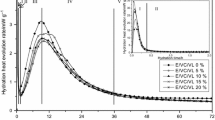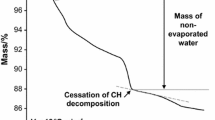Abstract
Three vinyl acetate ethylene (VAE) latices and incorporated polyvinyl alcohol (PVOH) were investigated. Two of the VAE latices were stabilized by PVOH, while the third was stabilized with an anionic surfactant. The influence of VAE and PVOH on cement hydration was studied by means of isothermal heat flow calorimetry, ICP-OES and in situ XRD measurement. All of the latices prolonged the induction period with an increase in the polymer/cement ratio, whereas the latex stabilized by PVOH hardly influenced the hydration of the silicate phase. Instead, a strong secondary exothermic peak was observed. Based on the in situ XRD analysis, the peak was attributed to the rapid formation of ettringite. Furthermore, the concentration of SO42− in the pore solution was found to have reduced in the presence of polymers in the first hours of the hydration.









Similar content being viewed by others
References
Ohama Y (1998) Polymer-based admixtures. Cem Concr Compos. https://doi.org/10.1016/S0958-9465(97)00065-6
Warson H, Finch CA (2001) Fundamental chemistry of latices and applications in adhesives. In: Warson H, Finch CA (eds) Applications of synthetic resin latices, vol 1. Wiley, Chichester
van Gemert D (2007) In: Kyu-Seok Y (ed) Polymers in concrete. Kangwon National University, Chuncheon, pp 3–15
Sakai E, Sugita J (1995) Composite mechanism of polymer modified cement. Cem Concr Res. https://doi.org/10.1016/0008-8846(94)00120-N
Su Z, Sujata K, Bijen JMJM, Jennings HM, Fraaij ALA (1996) The evolution of the microstructure in styrene acrylate polymer-modified cement pastes at the early stage of cement hydration. Adv Cem Based Mater. https://doi.org/10.1016/S1065-7355(96)90041-3
Jenni A, Holzer L, Zurbriggen R, Herwegh M (2005) Influence of polymers on microstructure and adhesive strength of cementitious tile adhesive mortars. Cem Concr Res. https://doi.org/10.1016/j.cemconres.2004.06.039
Rottstegge J, Arnold M, Herschke L, Glasser G, Wilhelm M, Spiess HW, Hergeth WD (2005) Solid state NMR and LVSEM studies on the hardening of latex modified tile mortar systems. Cem Concr Res. https://doi.org/10.1016/j.cemconres.2004.10.003
Afridi MUK, Ohama Y, Demura K, Iqbal MZ (2003) Development of polymer films by the coalescence of polymer particles in powdered and aqueous polymer-modified mortars. Cem Concr Res. https://doi.org/10.1016/S0008-8846(02)01094-3
Ohama Y (1987) Principle of latex modification and some typical properties of latex-modified mortars and concretes adhesion; binders (materials); bond (paste to aggregate); carbonation; chlorides; curing; diffusion. Mater J. https://doi.org/10.14359/2463
Beeldens A, van Gemert D, Schorn H, Ohama Y, Czarnecki L (2005) From microstructure to macrostructure: an integrated model of structure formation in polymer-modified concrete. Mater Struct. https://doi.org/10.1617/14215
Evju C, Hansen S (2005) The kinetics of ettringite formation and dilatation in a blended cement with β-hemihydrate and anhydrite as calcium sulfate. Cem Concr Res. https://doi.org/10.1016/j.cemconres.2004.09.012
Do J, Soh Y (2003) Performance of polymer-modified self-leveling mortars with high polymer–cement ratio for floor finishing. Cem Concr Res. https://doi.org/10.1016/S0008-8846(02)01057-8
Cheung J, Jeknavorian A, Roberts L, Silva D (2011) Impact of admixtures on the hydration kinetics of Portland cement. Cem Concr Res. https://doi.org/10.1016/j.cemconres.2011.03.005
Baueregger S, Perello M, Plank J (2015) Impact of carboxylated styrene–butadiene copolymer on the hydration kinetics of OPC and OPC/CAC/AH: the effect of Ca2+ sequestration from pore solution. Cem Concr Res. https://doi.org/10.1016/j.cemconres.2015.03.004
Kong X, Emmerling S, Pakusch J, Rueckel M, Nieberle J (2015) Retardation effect of styrene-acrylate copolymer latexes on cement hydration. Cem Concr Res. https://doi.org/10.1016/j.cemconres.2015.04.014
Silva DA, Roman HR, Gleize PJP (2002) Evidences of chemical interaction between EVA and hydrating Portland cement. Cem Concr Res. https://doi.org/10.1016/S0008-8846(02)00805-0
Silva DA, Monteiro PJM (2005) Hydration evolution of C3S–EVA composites analyzed by soft X-ray microscopy. Cem Concr Res. https://doi.org/10.1016/j.cemconres.2004.05.049
Silva DA, Monteiro PJM (2005) Analysis of C3A hydration using soft X-rays transmission microscopy: effect of EVA copolymer. Cem Concr Res. https://doi.org/10.1016/j.cemconres.2005.02.002
Silva DA, Monteiro PJM (2006) The influence of polymers on the hydration of Portland cement phases analyzed by soft X-ray transmission microscopy. Cem Concr Res. https://doi.org/10.1016/j.cemconres.2006.05.010
Betioli AM, Hoppe Filho J, Cincotto MA, Gleize PJP, Pileggi RG (2009) Chemical interaction between EVA and Portland cement hydration at early-age. Constr Build Mater. https://doi.org/10.1016/j.conbuildmat.2009.06.033
Kotwica Ł, Małolepszy J (2011) In: Siasa Congresos SA, Palomo A, Zaragoza A, López Agüí, Juan Carlos (eds) Cementing a sustainable future: XIII ICCC international congress on the chemistry of cement, Madrid, 3–8 July, 2011 abstracts and proceedings. Instituto de Ciencias de la Construcción, Madrid
Lutz H, Hahner C (2002) In: Urban D, Takamura K (eds) Polymer dispersions and their industrial applications. Wiley, Weinheim, pp 329–354
Betioli AM, Gleize PJP, John VM, Pileggi RG (2012) Effect of EVA on the fresh properties of cement paste. Cem Concr Compos. https://doi.org/10.1016/j.cemconcomp.2011.10.004
Jansen D, Götz-Neunhoeffer F, Neubauer J, Hergeth WD (2010) Influence of polyvinyl alcohol on phase development during the hydration of Portland cement. ZKG Int 63(7–8):100–107
Ohama Y (1995) Handbook of polymer-modified concrete and mortars: properties and process technology. Noyes Publications, Park Ridge
Péra J, Husson S, Guilhot B (1999) Influence of finely ground limestone on cement hydration. Cem Concr Compos. https://doi.org/10.1016/S0958-9465(98)00020-1
Korpa A, Kowald T, Trettin R (2008) Hydration behaviour, structure and morphology of hydration phases in advanced cement-based systems containing micro and nanoscale pozzolanic additives. Cem Concr Res. https://doi.org/10.1016/j.cemconres.2008.02.010
Frías M, de Rojas MIS, Cabrera J (2000) The effect that the pozzolanic reaction of metakaolin has on the heat evolution in metakaolin-cement mortars. Cem Concr Res. https://doi.org/10.1016/S0008-8846(99)00231-8
Carrà S, Sliepcevich A, Canevarolo A, Carrà S (2005) Grafting and adsorption of poly(vinyl) alcohol in vinyl acetate emulsion polymerization. Polymer. https://doi.org/10.1016/j.polymer.2004.11.061
Gilmore CM, Poehlein GW, Schork FJ (1993) Modeling poly(vinyl alcohol)-stabilized vinyl acetate emulsion polymerization. I. Theory. J Appl Polym Sci 48(8):1449–1460
Wadsö L (2005) Applications of an eight-channel isothermal conduction calorimeter for cement hydration studies. Cem Int 5:94–101
Jansen D, Goetz-Neunhoeffer F, Lothenbach B, Neubauer J (2012) The early hydration of ordinary portland cement (OPC): an approach comparing measured heat flow with calculated heat flow from QXRD. Cem Concr Res. https://doi.org/10.1016/j.cemconres.2011.09.001
von Daake H, Stephan D (2016) Setting of cement with controlled superplasticizer addition monitored by ultrasonic measurements and calorimetry. Cem Concr Compos. https://doi.org/10.1016/j.cemconcomp.2015.11.004
Hosoda N, Sugawara A, Kato T (2003) Template effect of crystalline poly(vinyl alcohol) for selective formation of aragonite and vaterite CaCO3 thin films. Macromolecules 36:6449–6452
Juilland P, Gallucci E, Flatt R, Scrivener K (2010) Dissolution theory applied to the induction period in alite hydration. Cem Concr Res. https://doi.org/10.1016/j.cemconres.2010.01.012
Bullard JW, Jennings HM, Livingston RA, Nonat A, Scherer GW, Schweitzer JS, Scrivener KL, Thomas JJ (2011) Mechanisms of cement hydration. Cem Concr Res. https://doi.org/10.1016/j.cemconres.2010.09.011
Pöllmann H, Sieksmeier J (2012) Dispersionspulver in zementären Systemen. ZKG Int 9:56–61
Cannon LA, Pethrick RA (1999) Effect of the glass-transition temperature on film formation in 2-ethylhexyl acrylate/methyl methacrylate emulsion copolymers. Macromolecules. https://doi.org/10.1021/ma990273i
Gartner EM, Young JF, Damidot D, Jawed I (2002) In: Bensted J, Barnes P (eds) Structure and performance of cements, 2nd edn. E & Fn Spon, London, pp 57–113
Hesse C, Goetz-Neunhoeffer F, Neubauer J, Braeu M, Gaeberlein P (2009) Quantitative in situ X-ray diffraction analysis of early hydration of Portland cement at defined temperatures. Powder Diffr. https://doi.org/10.1154/1.3120603
Taylor JC, Aldridge LP, Matulis CE, Hinczak I (2002) In: Bensted J, Barnes P (eds) Structure and performance of cements, 2nd edn. E & Fn Spon, London
Mitchell LD, Margeson JC, Whitfield PS (2006) Quantitative Rietveld analysis of hydrated cementitious systems. Powder Diffr. https://doi.org/10.1154/1.2204056
Jin Y, Stephan D, Hergeth WD (2014) In: Middendorf B, Wetzel A, Arend J (eds) GDCh monographie: tagung bauchemie 2014. Gesellschaft Deutscher Chemiker, Frankfurt am Main, pp 88–91
Yuan T, Wang J, Li Z (2010) Measurement and modelling of solubility for calcium sulfate dihydrate and calcium hydroxide in NaOH/KOH solutions. Fluid Phase Equilib. https://doi.org/10.1016/j.fluid.2010.06.012
Brandt F, Bosbach D (2001) Precipitation in the presence of cellulose ethers. J Cryst Growth. https://doi.org/10.1016/s0022-0248(01)01637-2
Marten FL (2002) Encyclopedia of polymer science and technology. Wiley, Hoboken, pp 399–437
Müller I (2007) Influence of cellulose ethers on the kinetics of early Portland cement hydration. Ph. D. dissertation, Karlsruhe, Germany
Acknowledgements
Yu Jin gratefully acknowledges the scholarship provided by DAAD (German academic exchange service). The authors also greatly appreciate Dr. Wolf-Dieter Hergeth for the advices, Dr. Ulf Dietrich for the synthesis of model latices and Dr. Ingo Müller for the helpful discussions.
Author information
Authors and Affiliations
Corresponding author
Rights and permissions
About this article
Cite this article
Jin, Y., Stephan, D. Hydration kinetics of Portland cement in the presence of vinyl acetate ethylene latex stabilized with polyvinyl alcohol. J Mater Sci 53, 7417–7430 (2018). https://doi.org/10.1007/s10853-018-2074-1
Received:
Accepted:
Published:
Issue Date:
DOI: https://doi.org/10.1007/s10853-018-2074-1




